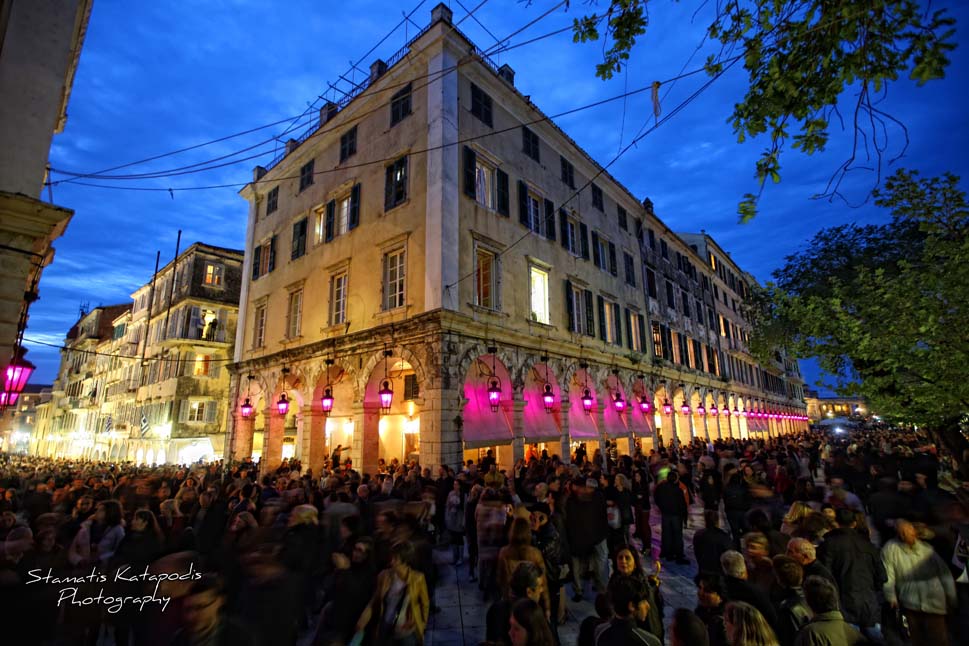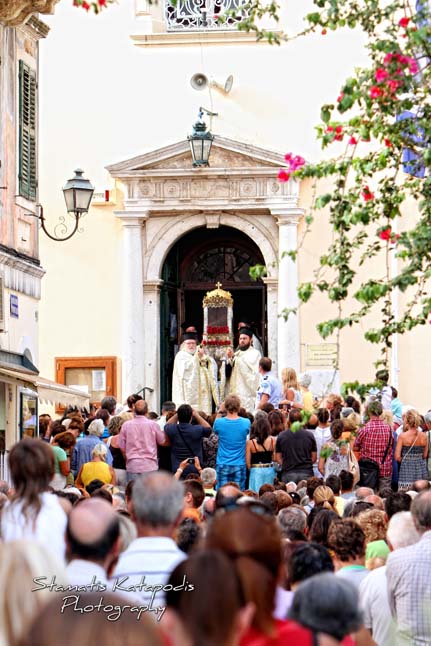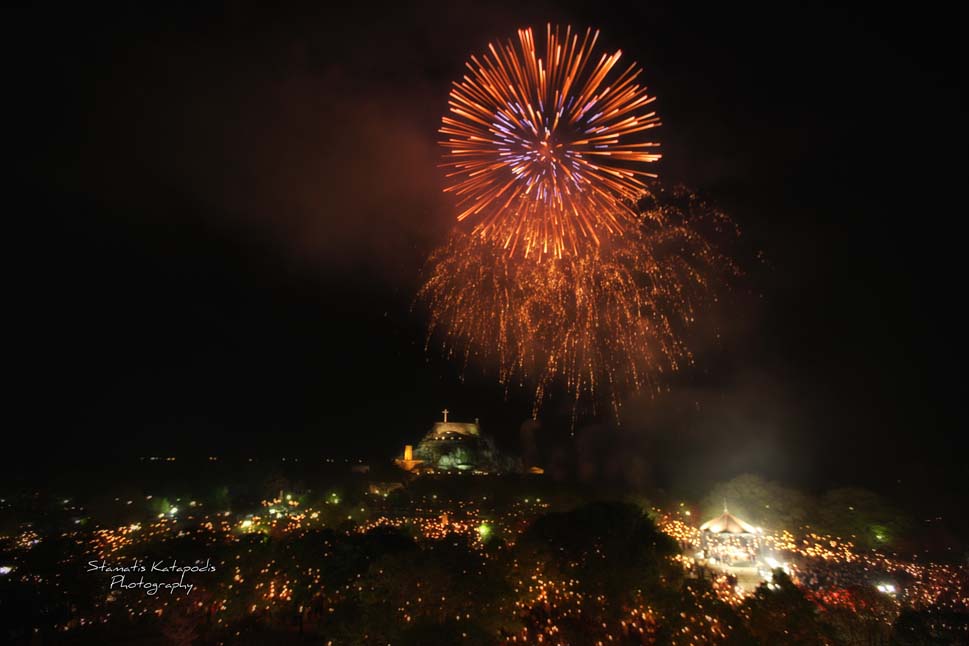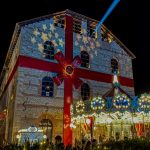Corfu is one of the most favorite Easter destinations for Greeks. In the Homeric island of Phaecians unique Easter customs, old traditions and music events accompany the principal festival of Christianity. From Lazarus Saturday, Corfu is up and ready to welcome visitors from every part of the country who arrive at the island to live the incomparable experience of a Corfiot Easter. The prominent brass bands of the island (Philharmonikai) dating back to 1840, the choral church music influenced from the Venetian Rule period as well as the profound music background of Corfu set up the perfect background for a harmonious yet solemn Easter. Each day of the Holy Week in Corfu is special and keeps visitors’ attention undivided thanks to its unique and centuries-old customs.
PALM SUNDAY
“Ton Vagiòne”, which is the Corfiot way to say “On Palm Sunday”, begins the pious period of the Holy Week on the island. The religious rituals for the celebration of Easter begin with the Procession of the relics of St. Spyridon, the patron saint of Corfu, which takes place every year since 1630 to commemorate the saviour of the island from the deadly plague. The route of the procession follows the imaginary line of the old Venetian walls. At the end of the procession all 18 brass bands of Corfu parade in the center of the town marching joyously. On Palm Sunday’s night the Mantzaros Philharmonic Society gives a concert at the Municipal Theater of Corfu.
HOLY MONDAY
On Holy Monday, the scent of fogàtsa and kolombìna wafts through the neigborhoods of Corfu… Bakers and housewives roll up their sleeves to bake the traditional Easter breads (tsourèki) according to the old Venetian recipe, which includes kumquat liquer and spoon sweet. Round fogàtsa is the “Easter bread”, while kolombina —“small pigeon” in Italian— is a braided tsouréki with a red egg and a pigeon’s feather. Venetians used to make this pigeon-like Easter bread as a symbol of the Holy Spirit. At night, the lights of the town add to the solemn atmosphere of the Holy Week as they take a mournful color. From the promenade to the streetlights of Liston square and the Cross of the Old Fortress everything turns into purple.
HOLY TUESDAY
On Holy Tuesday, the brass bands and choirs of the town of Corfu chant the Hymn of Kassiani at the Colonnade of the Palace of St. Michael and St. George, sending shivers of emotion, and the night continues with the established musical poetic night of the Corfu Expressions Organization titled “From Golgotha to Resurrection”.
HOLY WEDNESDAY
On Holy Wednesday, congregants gather early in the churches of Corfu for the Service, while on 20:30 p.m. locals and visitors head to the Municipal Theater, where San Giacomo Municipal Choir of Corfu stages a Church Music concert for the Holy Week.
MAUNDY THURSDAY
On Maundy Thursday, a unique custom, the Washing of the Feet ritual, is reenacted in the Cathedral of Saint James and Saint Christopher of the town of Corfu. In a symbolic gesture, the Catholic Archbishop washes the feet of twelve children, just as Jesus Christ washed the feet of His disciples after the Last Supper according to tradition. Every time the reading of a Gospel ends, one of the twelve candles burning inside the temple is extinguished. As for the villages of Corfu, Maundy Thursday is inextricably linked with an old unusual local tradition. During the Matins of the Twelve Passion Gospels in the churches, women crochet the so called gaitàni —a silk thread lace, used to embellish sleeves and hemlines— and stop each time the reading of a Gospel ends.
GOOD FRIDAY
On Good Friday, the Deposition of Christ ritual is held in deep solemnity as bells chime mournfully in every corner of the island. The processions of epitàphioi in Corfu begin at 14:00 p.m. Until the evening all 33 epitàphioi of the island, as many as the years of Christ, gather at the center of the town. The last to appear is the imposing Επιτάφιος of the Metropolitan Church of Corfu, also known as Panagia Spileotissa. Each procession is accompanied by Philharmonikai, kóro (choir), skóles (banners), tórtses (big candles) and manuàlia (Venetian lanterns). The mournful arias of Philharmonikai intensify this gloomy atmosphere, with Albinoni’s “Adagio” by the Old Philharmonikai mesmerizing everyone.
HOLY SATURDAY
On 06:00 a.m. of Holy Saturday, congregants of Panagia Faneromeni Church in the old town of Corfu slam the pews and the altarpiece of the temple, shaking the church to the ground, in order to reenact the earthquake that was caused by the Resurrection of Christ. Three hours later, on 09:00 a.m., the procession of the Epitaphios of Saint Spyridon, the patron saint of Corfu, takes place at the cobblestone streets (kantoùnia) of the island accompanied by the three major phliarmonikai performing the mournful marches of Franco Faccio’s “Amleto”, Michelis’s “Calde Lacrime” and Beethoven’s “Marcia Funebre”.
On 12:00 the bells of all churches begin to chime joyously, announcing the First Resurrection of Christ, and mood instantly changes; it is time for one of the most famous Greek Easter customs, bòtides. Corfiots line up at balconies of Liston street’s mansions and start hurling clay pots (bòtides) ornate with red ribbons and filled with water. All spectators underneath run to pick up at least one shard as it is thought they bring good luck. An equally famous and old Corfiot Easter custom is that of Mastéla, reviving in Pinia district, at the old commercial center of the town of Corfu. Locals put an open barrel full of water and decorated with flowers and ribbons, mastéla. People passing by throw coins inside the barrel and make a wish. As soon as the church bells announce the “First Resurrection”, the first to dive in the barrel gets to keep all the coins!
As the night of Holy Saturday approaches, people gather at the churches of Corfu for the Easter Mass. The Holy Fire is firstly delivered at the Cathedral of Saint James and Saint Christopher where the Catholic Easter Mass is held, yet on 11:00 p.m. all congregants go to Agia Paraskevi Church, so they can attend the Orthodox service as well. Then they all gather in Spianada, the largest square in the Balkans, where the three major Philharmonikai of Corfu perform “Erhondai Graikoi” (“The Greeks are coming”), the march of the Reunion of the Ionian islands with Greece and a spectacular extravaganza begins, with petards and fireworks coming down like rain from the Old Fortress of Corfu.
EASTER SUNDAY
Early in the morning on Easter Sunday the icon of the Resurrection of Christ, accompanied by Philharmonikai, choirs, students and scouts, is paraded in front of every church. According to tradition, locals eat tsilihourda on this day, the Corfiot version of mageiritsa soup, that is eaten with a fork, is very thick and made with liver, greens and herbs. Yet, apparently this custom will soon cease to exist, as Corfiots now choose Easter Lamb on the spit like the rest of Greeks. You can see it for yourself if you decide to visit Corfu of bòtides, mastèla and Philharmonikai this Easter!










